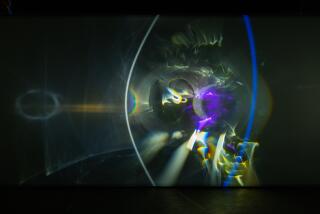Major League Acquisition : Museum: MOCA increases its photographic holdings five-fold. The collection gives it a firm foundation in photography-- and a model for the future.
- Share via
In a move that establishes the Museum of Contemporary Art as a major collector of photography, increases its photographic holdings five-fold and charts a course for future acquisitions, the museum has purchased a collection of 2,100 prints for $1.15 million. The collection, built by former New York photography dealer Robert Freidus, traces the development of American documentary photography from the 1940s through the 1980s in the work of 11 artists.
The acquisition is largely composed of narrative series of images that have been published as books. Artists represented include French artist Brassai and 10 Americans: Diane Arbus, Larry Clark, Robert Frank, Lee Friedlander, Nan Goldin, Helen Levitt, Danny Lyon, Roger Mertin, John Pfahl and Garry Winogrand.
Under terms of the deal, MOCA has made an initial payment of $250,000, contributed by the museum’s Collectors Committee. Funds will be raised for the balance, to be paid during the next four to five years, MOCA Director Richard Koshalek said.
“We’ve pulled a rabbit out of a hat, like we did with the Panza collection, in terms of in-depth holdings of major bodies of work by internationally regarded artists,” Koshalek said. In 1984, the then-fledgling museum scored a coup by purchasing 80 pieces of Abstract Expressionist and Pop art by nine artists for $11 million from Italian collector Giuseppe Panza di Biumo.
That purchase, which was paid off over a period of four years, forms the bedrock of the institution’s painting and sculpture collection. Landing the Panza material has helped MOCA persuade other collectors to donate artworks to the museum, Koshalek said, and he hopes the Freidus collection will have a similarly magnetic quality. “This is an extremely important beginning,” he said.
Adding the Freidus collection to MOCA’s holding of about 500 photographs--including 185 images by Max Yavno and works by Ansel Adams, Lewis Baltz and Cindy Sherman--is consistent with the museum’s collecting mission, Koshalek said. “We knew when we were planning MOCA that we couldn’t amass a huge, comprehensive collection, so we decided to collect key figures in depth.”
Discussions about the purchase have gone on for about a year, he said. MOCA’s chief curator, Paul Schimmel, who knew the collection through his longtime friend, Mark Freidus, a cousin of Robert Freidus, was the museum’s initial contact. While Schimmel helped pave the way, Koshalek credits the acquisition to two MOCA trustees and patrons who are photography collectors--Leonard Vernon and Audrey Irmas, head of the acquisitions committee. But persuading the board of trustees to go along with the deal wasn’t difficult, he said. “They felt that MOCA was at the right stage to acquire a major collection of photography that would set a standard for collecting and declare our ambition in that area.”
Robert Freidus, who operated a photography gallery in New York from 1976 to 1984 and built his collection during the same period, is now retired and living in London. Reached by telephone while traveling in Belgium, he said that he was pleased about the sale but expressed a bit of ambivalence about his collection’s new home.
“I’m happy to have the money, but I’m a New Yorker. I would be happier if the Whitney had bought it,” he said, referring to Manhattan’s Whitney Museum of American Art. “Los Angeles isn’t my favorite city, but I’m ready to reconsider.”
Although his cousin handled the sale, Robert Freidus said that he had talked to many possible buyers. “When it got down to serious negotiations, there were only two other contenders besides MOCA,” he said, but declined to name them.
“What does make me happy is that MOCA is a serious place that will look after the photographs,” Freidus said. The fact that his collection gives the museum a firm foundation in photography and a model for future acquisitions also pleases him.
Freidus started his collection with Larry Clark’s work and, with few a exceptions, continued a pattern of buying complete bodies of images by artists who produce series within a narrative tradition. “These works are made to be seen as one piece,” he said. “If there are 50 works in a series, it only seems appropriate to have all 50 because they tell a story. So that’s what I did.” Anything less than a complete set is merely “a souvenir” or “a page from a diary,” he said.
According to Schimmel, plums of the holding include Robert Frank’s “Americans,” one of only four complete sets of 85 prints; an exceptionally complete and high-quality group of Lee Friedlander’s work including 73 portraits and 45 self-portraits, and 80 early posthumous prints by Diane Arbus.
“But this is the opposite of a gem collection, such as the Getty’s where emphasis is put on uniqueness,” Schimmel said. “This is about photography as mass media, published in books.”
As for duplications of works already owned by MOCA, Schimmel said they include about 20 pieces by Winogrand and Clark’s “Tulsa” portfolio, but the acquisition includes “Outtakes and Additions” not published in Clark’s 50-image portfolio.
Koshalek said that MOCA’s newly enlarged collection--which focuses on the last 50 years of photography and encompasses both the concepts of “freezing an image” and “creating an image”--will not duplicate broader historical collections at the Getty, the Los Angeles County Museum of Art and the Huntington Library, Art Collections and Botanical Gardens.
MOCA is planning to show a large sampling of entire Freidus collection in the spring, followed by a series of exhibitions featuring individual artists.
More to Read
The biggest entertainment stories
Get our big stories about Hollywood, film, television, music, arts, culture and more right in your inbox as soon as they publish.
You may occasionally receive promotional content from the Los Angeles Times.










